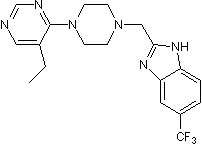PF 4708671
Chemical Name: 2-[[4-(5-Ethylpyrimidin-4-yl)piperazin-1-yl]methyl]-5-(trifluoromethyl)-1H-benzo[d]imidazole
Purity: ≥98%
Biological Activity
PF 4708671 is a cell-permeable inhibitor of p70 ribosomal S6 kinase (S6K1 isoform) (Ki = 20 nM; IC50 = 160 nM). Suppresses the S6K1-mediated phosphorylation of S6, Rictor and mTOR in response to IGF1; displays no effect on the activity of RSK and MSK in vivo. Exhibits no significant inhibition of S6K2 or other AGC kinases (e.g. Akt, PKA and ROCK) in vitro.Technical Data
The technical data provided above is for guidance only.
For batch specific data refer to the Certificate of Analysis.
Tocris products are intended for laboratory research use only, unless stated otherwise.
Additional Information
Background References
-
Characterisation of PF-4708671 a novel and highly specific inhibitor of p70 ribosomal S6 kinase (S6K1).
Pearce et al.
Biochem.J., 2010;431:245
Product Datasheets
Reconstitution Calculator
Molarity Calculator
Citations for PF 4708671
The citations listed below are publications that use Tocris products. Selected citations for PF 4708671 include:
18 Citations: Showing 1 - 10
-
Transcriptome, proteome, and protein synthesis within the intracellular cytomatrix.
Authors: Sandra L Et al.
iScience 2023;26:105965
-
Selective Eradication of Colon Cancer Cells Harboring PI3K and/or MAPK Pathway Mutations in 3D Culture by Combined PI3K/AKT/mTOR Pathway and MEK Inhibition.
Authors: Markus Et al.
Int J Mol Sci 2023;24
-
S6K1 controls adiponectin expression by inducing a transcriptional switch: BMAL1-to-EZH2.
Authors: Min Gyu Et al.
Exp Mol Med 2022;54:324-333
-
Nuclear S6K1 Enhances Oncogenic Wnt Signaling by Inducing Wnt/β-Catenin Transcriptional Complex Formation.
Authors: Jong Woo Et al.
Int J Mol Sci 2022;23
-
mTORC1 promotes TOP mRNA translation through site-specific phosphorylation of LARP1.
Authors: An-Dao Et al.
Nucleic Acids Res 2021;49:3461-3489
-
Cell-type-specific profiling of human cellular models of fragile X syndrome reveal PI3K-dependent defects in translation and neurogenesis.
Authors: Lu Et al.
Cell Rep 2021;35:108991
-
Tofacitinib overcomes an IFNγ-induced decrease in NK cell-mediated cytotoxicity via the regulation of immune-related molecules in LC-2/ad.
Authors: Masao Et al.
Thorac Cancer 2021;12:775-782
-
Loss of Kat2a enhances transcriptional noise and depletes acute myeloid leukemia stem-like cells.
Authors: George Et al.
Elife 2020;9
-
The 3-Phosphoinositide-Dependent Protein Kinase 1 Inhibits Rod Photoreceptor Development.
Authors: Xing Et al.
Front Cell Dev Biol 2018;6:134
-
Synaptically driven phosphorylation of ribosomal protein S6 is differentially regulated at active synapses versus dendrites and cell bodies by MAPK and PI3K/mTOR signaling pathways.
Authors: Pirbhoy Et al.
Learn Mem 2017;24:341
-
Loss of ULK1 increases RPS6KB1-NCOR1 repression of NR1H/LXR-mediated Scd1 transcription and augments lipotoxicity in hepatic cells.
Authors: Sinha Et al.
Autophagy 2017;13:169
-
Autophagy is a signature of a signaling network that maintains hematopoietic stem cells.
Authors: Michelle Et al.
PLoS One 2017;12:e0177054
-
Mechanistic Target of Rapamycin Complex 1/S6 Kinase 1 Signals Influence T Cell Activation Independently of Ribosomal Protein S6 Phosphorylation.
Authors: Salmond Et al.
J Immunol 2015;195:4615
-
Environmental enrichment improves learning and memory and long-term potentiation in young adult rats through a mechanism requiring mGluR5 signaling and sustained activation of p70s6k.
Authors: Hullinger Et al.
Neurobiol Learn Mem 2015;125:126
-
Regulation of cardiac expression of the diabetic marker microRNA miR-29.
Authors: Arnold Et al.
PLoS One 2014;9:e103284
-
Kinome profiling reveals breast cancer heterogeneity and identifies targeted therapeutic opportunities for triple negative breast cancer.
Authors: Al-Ejeh Et al.
Tuberc Respir Dis (Seoul) 2014;5:3145
-
mTORC1 inhibition induces pain via IRS-1-dependent feedback activation of ERK.
Authors: Melemedjian Et al.
Pain 2013;154:1080
-
Convergence of the mammalian target of rapamycin complex 1- and glycogen synthase kinase 3-β-signaling pathways regulates the innate inflammatory response.
Authors: Wang Et al.
J Immunol 2011;186:5217
FAQs
No product specific FAQs exist for this product, however you may
View all Small Molecule FAQsReviews for PF 4708671
There are currently no reviews for this product. Be the first to review PF 4708671 and earn rewards!
Have you used PF 4708671?
Submit a review and receive an Amazon gift card.
$25/€18/£15/$25CAN/¥75 Yuan/¥2500 Yen for a review with an image
$10/€7/£6/$10 CAD/¥70 Yuan/¥1110 Yen for a review without an image

